GLEBE TREES AND SHRUBS
Honey-locust (Gleditsia triacanthos)
Form
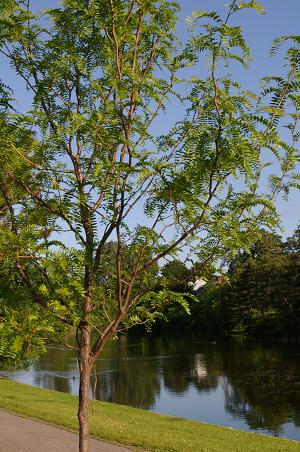 Queen Elizabeth Dr at Brown's Inlet, June 21, 2008. Young tree.
Most honey-locust in the Glebe are small trees, occasionally taller.
Without leaves, they have a sparse form without much branching. The lower
branches are quite horizontal.
Queen Elizabeth Dr at Brown's Inlet, June 21, 2008. Young tree.
Most honey-locust in the Glebe are small trees, occasionally taller.
Without leaves, they have a sparse form without much branching. The lower
branches are quite horizontal.
Leaves
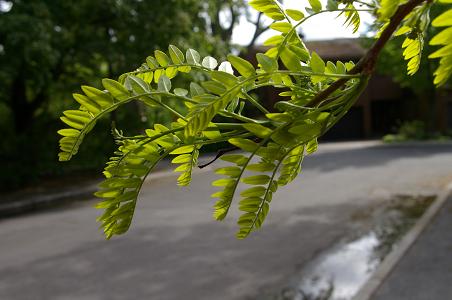
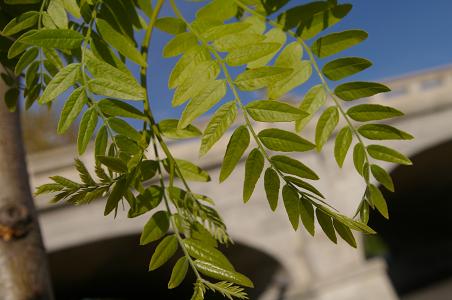 Woodlawn Ave. May 19, 2008. Queen Elizabeth Drive at QE Place, May 24, 2008.
Most of the honey-locust trees in the Glebe appear to be thornless (Gleditsia triacanthos var inermis).
Leaflets can be toothed or not. It is late in getting its leaves - noted rougly from mid-May in 2008.
Woodlawn Ave. May 19, 2008. Queen Elizabeth Drive at QE Place, May 24, 2008.
Most of the honey-locust trees in the Glebe appear to be thornless (Gleditsia triacanthos var inermis).
Leaflets can be toothed or not. It is late in getting its leaves - noted rougly from mid-May in 2008.
Bark
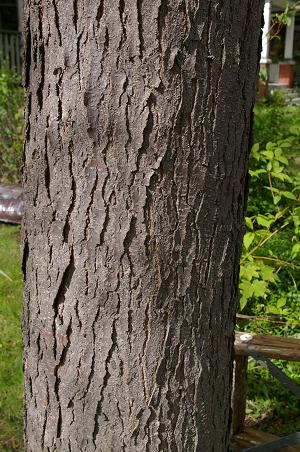
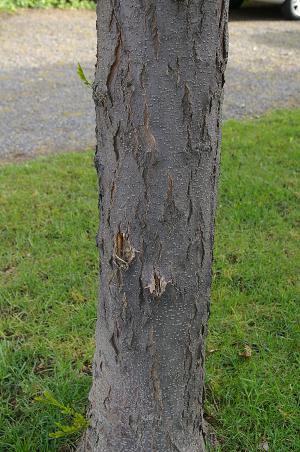 Younger trees have cracking bark.
Younger trees have cracking bark.
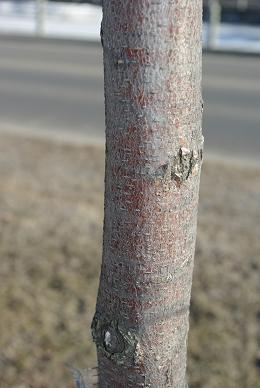 March 21, 2009
Youngest trees have smoother bark. Path on QE Dr at Brown's inlet.
March 21, 2009
Youngest trees have smoother bark. Path on QE Dr at Brown's inlet.
Buds
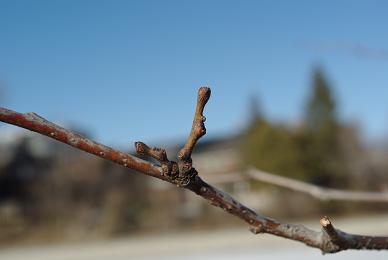 March 21, 2009
There are no buds to see. One source says they are covered and hidden and what you see are mainly
stubs, maybe dwarf shoots or aborted shoots.
March 21, 2009
There are no buds to see. One source says they are covered and hidden and what you see are mainly
stubs, maybe dwarf shoots or aborted shoots.
Similar species
Mountain ash and staghorn sumac have similar compound, toothed leaves in an alternate pattern.
Sumac's leaflets are generally longer than honey-locust. False spirea has leaves similar to staghorn sumac.
Ash, red elderberry and elder: these have toothed compound leaves but in an opposite pattern.
List of trees and shrubs with alternate, compound, toothed leaves
List of trees and shrubs with alternate, compound, untoothed leaves
 Queen Elizabeth Dr at Brown's Inlet, June 21, 2008. Young tree.
Most honey-locust in the Glebe are small trees, occasionally taller.
Without leaves, they have a sparse form without much branching. The lower
branches are quite horizontal.
Queen Elizabeth Dr at Brown's Inlet, June 21, 2008. Young tree.
Most honey-locust in the Glebe are small trees, occasionally taller.
Without leaves, they have a sparse form without much branching. The lower
branches are quite horizontal.

 Woodlawn Ave. May 19, 2008. Queen Elizabeth Drive at QE Place, May 24, 2008.
Most of the honey-locust trees in the Glebe appear to be thornless (Gleditsia triacanthos var inermis).
Leaflets can be toothed or not. It is late in getting its leaves - noted rougly from mid-May in 2008.
Woodlawn Ave. May 19, 2008. Queen Elizabeth Drive at QE Place, May 24, 2008.
Most of the honey-locust trees in the Glebe appear to be thornless (Gleditsia triacanthos var inermis).
Leaflets can be toothed or not. It is late in getting its leaves - noted rougly from mid-May in 2008.

 Younger trees have cracking bark.
Younger trees have cracking bark.
 March 21, 2009
Youngest trees have smoother bark. Path on QE Dr at Brown's inlet.
March 21, 2009
Youngest trees have smoother bark. Path on QE Dr at Brown's inlet.
 March 21, 2009
There are no buds to see. One source says they are covered and hidden and what you see are mainly
stubs, maybe dwarf shoots or aborted shoots.
March 21, 2009
There are no buds to see. One source says they are covered and hidden and what you see are mainly
stubs, maybe dwarf shoots or aborted shoots.